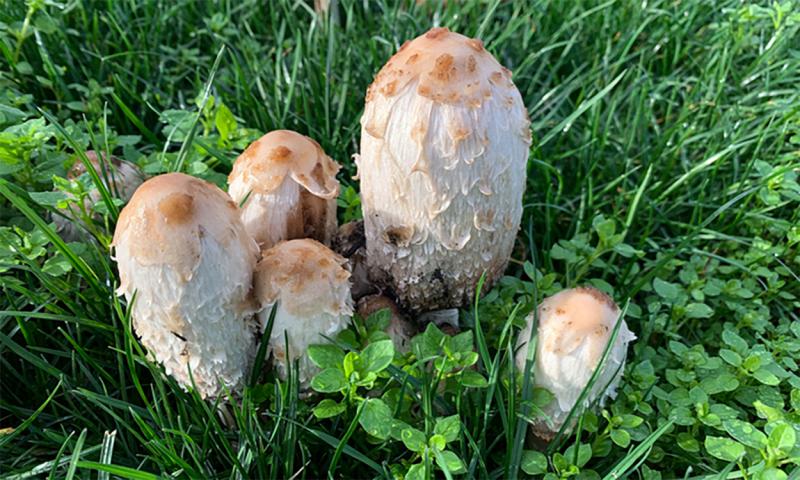Written by Vaughn Reints, SDSU Extension Horticulture Assistant, under the direction and review of Madalyn Shires, Kristine Lang, and Prairey Walkling.
A lush, green yard can be a source of pride for any homeowner. However, the sudden appearance of mushrooms can quickly dampen your enthusiasm. While mushrooms can be fascinating organisms, their presence in your yard may indicate an underlying issue. This article will provide you with some tips on how to effectively get rid of mushrooms and maintain a healthy, mushroom-free lawn.
Understanding the Role of Mushrooms

Mushrooms are the fruiting bodies of fungi that thrive on decaying organic matter. They play an essential role in breaking down dead material and recycling nutrients back into the soil for plants to utilize. Therefore, it's important to remember that the presence of mushrooms is often a sign of an underlying fungal network working below the surface. These fungal networks can be extensive and exist for many months to years before mushrooms are produced. It is important to remember that mushrooms in your lawn are rarely dangerous to other plants. However, mushrooms that are growing on living plants, especially trees, can be indicators of tree health issues, and those should not be removed without investigating underlying problems.
Mushroom Management Tips
- Identify the underlying cause.
To effectively eliminate mushrooms from your yard, it's crucial to identify the underlying cause. Some common causes include excess moisture, shaded areas, compacted soil, decaying tree stumps or roots, or organic debris. Understanding the root cause will help you address the issue and prevent future mushroom growth.
- Remove organic debris.
Mushrooms thrive on decomposing organic matter, such as dead leaves, wood chips, or rotting tree stumps. Regularly rake and remove any fallen leaves, twigs, or other organic debris from your yard. Pay special attention to shaded areas, or places where moisture tends to accumulate, as these are prime spots for mushroom growth.
- Improve drainage.
Excess moisture is a significant factor in mushroom growth. Ensure proper drainage in your yard by addressing any areas prone to water accumulation. Correcting the grading or using drainage solutions, like French drains, can help redirect water away from problem areas, reducing the likelihood of mushrooms appearing.
- Increase sunlight exposure.
Mushrooms thrive in shaded areas with limited sunlight. If you have trees or shrubs that cast shadows over your lawn, consider pruning or trimming them to allow more sunlight to reach the ground. Increasing sunlight exposure will make it less favorable for mushrooms to grow.
- Aerate and loosen compact soil.
Compacted soil restricts water drainage and prevents proper airflow, creating an environment conducive to mushroom growth. Regularly aerate your lawn to loosen compacted soil and improve overall soil health. This process allows water, nutrients, and oxygen to reach the grass roots, discouraging mushroom growth.
- Avoid overwatering.
Overwatering not only creates the ideal conditions for mushrooms, but also weakens the grass roots and promotes fungal growth. Water your lawn deeply, but infrequently, ensuring that the soil has enough time to dry out between watering sessions. Aim for early-morning watering to allow the grass to dry during the day, reducing moisture accumulation.
- Organic solution.
Before trying fungicides, try a mixture of vinegar and water! Mix 5 tablespoons of vinegar per gallon of water and pour it into a sprayer. Remove the mushrooms and spray the location where the mushrooms were.
- Fungicides as a last resort.
If you've tried the above methods without success or are dealing with a persistent mushroom problem, you may consider using fungicides. However, it's essential to remember that fungicides should only be used as a last resort and according to the manufacturer's instructions. Consult with a professional if you're unsure about the appropriate product to use or have concerns about the impact on the environment.
Conclusion
While mushrooms can be fascinating to observe, their presence in your yard may indicate underlying issues that require attention. By understanding the causes and implementing the appropriate preventive measures, you can effectively get rid of mushrooms and maintain a healthy, mushroom-free lawn. Remember, a well-maintained yard with proper drainage, sunlight exposure, and minimal organic debris will discourage mushroom growth and contribute to a vibrant outdoor space.
Health Warning: Never eat mushrooms that you remove from your yard, as they are very difficult to identify and can be dangerous for human consumption.


